Star Wars: A Tale of Racism
Star Wars is fun, sci-fi escapism for white fans, but a minefield of painful caricatures and slurs for fans of color.
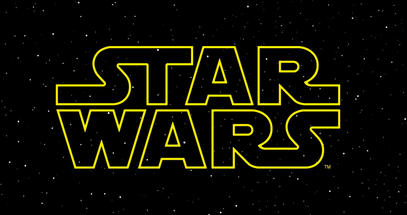
The Star Wars logo: instantly recognizable, beautifully designed. But what does it really represent?
Star Wars is a cultural juggernaut that has permeated a majority of American media since it premiered in 1977, and it continues to do so today. However, the majority of its audience, even devoted fans, are unaware of (if they do not participate in) the racism that is woven into the story and fanbase surrounding Star Wars. Everything from the most well-known pieces of the universe to the obscure details included only in old cartoons and comics contains an insidious racism that will often be overlooked by white fans but is glaringly obvious to fans of color.
The influence of nonwhite cultures on Star Wars cannot be ignored nor overstated when talking about the franchise in any capacity. As said by @clonehub, a prominent Star Wars blog and activist on Tumblr, “Star Wars would be nothing without nonwhite cultures, absolutely nothing. Star Wars is fueled by SEA [South-East Asian], SA [South-Asian], and Eastern Asian cultures. And Western Asian too, now that I think about it. It’s a lot.”
The Jedi- arguably the most well-known creation of Star Wars- had their ideology and design heavily inspired by Buddhist and Muslim beliefs, and were even named after an Arabic word, Al-Jeddi, meaning “master of the mystic warrior way.” These pieces of culture were appropriated by George Lucas while doing research for his movies. “George Lucas borrowed the aesthetic of [the Jedi’s] uniforms from North African tribesman and the Sufi brotherhood (which is a style said to still be worn by Saharan inhabitants of the Maghreb) and, though it’s not been confirmed, there were claims that the filmmaker spoke with members of the ‘Habibiyyah Sufi Order’ in Berkeley, CA, as research for the film.” (via arabamerica.com) “In an article released by a prominent Sufi Muslim order, ‘jeddi’ is mentioned by name and a definition that looks and sounds familiar to the Jedi Order of Star Wars and how the Force is viewed by them: ‘We are, at our core, a Movement of Jeddi; Sufi masters of Futuwwat (“the Way of the mystic-warrior”). We encourage adherents to train both physically AND spiritually, for their own personal edification and to enhance their knowledge and abilities in the Struggle. The Balance does not lie alone in contemplation, prayer and meditation; nor does it lie alone in action and revolution.’” (via royalhandmaidens.tumblr.com, whose posts were a huge source of information for this article.) This appropriation becomes all the more offensive when paired with the Islamophobia that would arise in Star Wars media after 9/11.
Other Islam-influenced parts of Star Wars include the Mirialans, an alien species which were first introduced in the novel “Star Wars: Cloak of Deception” (2001) and expanded on in further novels. Only two members of this species are ever prominently shown onscreen: Jedi Master Luminara Unduli and her padawan, Barriss Offee, who appear mostly in “Star Wars: The Clone Wars” (2008-2020). Both Luminara and Barriss spend the majority of their scenes dressed head-to-toe in robes that closely resemble popular forms of Muslim modesty wear, and Barriss’ clothing in particular appears designed to resemble a hijab. The Mirialans’ facial tattoos are also heavily reminiscent of the tattoos known as Sheen Kaal, worn by Pashtun people, who are majority Sunni Muslim. Furthermore, Barriss’ name is a real-life Muslim name that means “peace”, and in novels that feature these two characters, Mirialan culture is described in ways heavily reminiscent of Muslim beliefs. This coding was innocent, even a positive piece of representation, until the 2012 Clone Wars multi-episode “Wrong Jedi” arc, in which Barriss suddenly becomes a violent terrorist and bombs the Jedi temple for poorly-defined reasons. Due to the fact that Barriss and Luminara were seemingly styled after Muslim women and that Islamophobia in American media often portrays Muslim people as violent terrorists, this was a horrific and deeply racist choice on the part of the Clone Wars writers and producers. According to The Racialization of Islam in American Law, “The widespread acceptance of the 9/11 ‘Muslim terrorist’ stereotype or trope has altered the American understanding of Islam. Islam has come to be racialized through the racialization of Muslims, both immigrants and those born [in America]. In particular, the racial trope of the Muslim terrorist has come to displace Islam as faith.”

Star Wars has a laundry list of appropriations and demonizations of Islamic culture under its belt, including designing Jabba the Hutt’s palace after several mosques, the fact that Jabba’s name is based off of one of the 99 names of Allah from the Qur’an, and one of the images used in concept art of ancient Jedi texts being a shrunken down version of the works of Al-Biruni from the Islamic Golden Age. There are also dozens of names and words in Star Wars that were meant to sound ‘alien’ but in reality were simply anglicized versions of Arabic, Turkish, or Urdu words and names. Examples include Aayla (Arabic; noble), Ackbar (akbar, Arabic; greater), Ghorfa (Arabic; chamber), and Mustafar (mustafa, Arabic; the chosen one) [via royalhandmaidens.tumblr.com].
Islam was not the only cultural export of Northern Africa that was marred by Star Wars, however. The Tuskens, a species first appearing in “Star Wars IV: A New Hope” (1977) and reappearing sporadically throughout other Star Wars media, were designed after the Bedouin people of Northern Africa in dress and lifestyle. The Tuskens are described by Wookieepedia as follows: “A nomadic culture, Tusken clan groups consisted of 20 to 30 individuals, and were led by clan leaders, tribal chiefs, and warlords… All Sand People wore mouth grilles and eye coverings to retain moisture and keep sand out. However, their need to protect their bodies from Tatooine’s weather grew into a taboo against exposing any part of their bodies in public. Because of this, Tuskens almost never unmasked themselves, even in front of one another. They were forbidden to remove their clothing in front of others except at childbirth, on their wedding night, and at coming-of-age ceremonies.” This nomadic lifestyle, along with the head-to-toe coverings that are not to be removed in front of people, are highly reminiscent of the Bedouin people’s nomadic history and traditional body-covering clothing. “Lucas has previously said that the Bedouin people of North Africa and the Middle East heavily influenced the design, culture, and history of the Tusken Raiders.” (via Screenrant)
The Tuskens are portrayed as subhuman, unintelligent beings, barely above animals, who commit acts of violence and theft against the white main characters with no motive. Star Wars fans of color are very much aware of the blatant racism of this, with @clonehub saying about the Tuskens: “At first I was okay with them, but since I’ve learned that they’re actually inspired by/based on the Bedouin people of northern Africa/Algeria; I realize that they’re deeply racist stereotypes, and I don’t like them.” The Tuskens were not even given a language, instead having sounds recorded from camels and donkeys dubbed over their scenes. In addition, the Tuskens are often referred to as ‘sand people’, which is, in real-life, a racial slur against Arabian people. The racism of the Tuskens does not end there, however- they are also anti-indigenous stereotypes.
Within the world of Star Wars, the Tuskens are the original inhabitants of Tatooine. All other characters living there are colonizers, who moved to Tatooine uninvited when the Tuskens’ defensive ability was decimated by an alien attack. Despite the fact that these people are unwelcome invaders who extract resources from the Tuskens’ land and attack them for defending their own home, the white colonizers are always portrayed as the heroes, while the Tuskens are portrayed as the savage villains. In “Star Wars: Attack of the Clones” (2002), the Tuskens kidnap, torture, and kill Anakin’s mother, Shmi, for no reason other than brutality for brutality’s sake. They are then summarily massacred by Anakin, who proceeds to deliver this line: “They’re like animals, and I slaughtered them like animals!” These writing decisions are an allegorical case of the “savage Indian” trope. “Hollywood has traditionally portrayed Indigenous peoples as tomahawk-wielding savages, ready to attack White characters and their families. These problematic representations also often have Indigenous characters engage in barbaric practices such as scalping people they have killed and sexually violating White women.” (via Thoughtco.com)
Anti-Asian racism is also quite prevalent within the universe of Star Wars, although less obvious and existing more in the animated series as opposed to the live action works (aside, of course, from lack of representation, which is all-encompassing). According to @clonehub: “Despite the franchise being fueled by various Asian cultures, it’s still heavily stereotypical in many of its portrayals of them. The Ming Po from TCW come to mind. The lack of prominent Asians on screen until the sequel trilogy and a spinoff series is worrying and incredibly frustrating.” Star Wars contains a handful of Asian main characters, ranging from Jedi to Mandalorians to Imperials to Rebels. The ones who receive generous amounts of screentime, however, are usually mistreated. Rose Tico, the most famous of the Asian Star Wars characters, was maligned in the sequels in favor of her white co-stars, and her actress, Kelly Marie Tran, was harassed online by racist fans so cruelly that she disappeared from the internet for her own safety. Fennec Shand was whitewashed by The Bad Batch, and Chirrut Imwe, Baze Malbus, Breha Organa, Depa Billaba, and Bodhi Rook are all dead, some with very little screentime as supporting characters.
Aside from mistreatment of individual characters, Star Wars also creates racist caricatures of Asian people out of aliens. The Ming Po, a minor alien race from “Star Wars: The Clone Wars” are not only offensively named in a clear attempt to ‘sound Asian’, but are dressed in a facsimile of traditional Chinese formal clothing, and have their hair models designed to emulate traditional Japanese hairstyles. The faces of the Ming Po are also designed in such a way that suggests Yellow Peril-Era stereotypes– with wide-set, squinting eyes and long goatees reminiscent of propaganda distributed to advocate for the Chinese Exclusion Act. Their culture and demeanor, as well, are portrayed as ‘meek’ and ‘submissive’, two well-known East Asian stereotypes. Finally, their planet is designed after Chinese architecture with Japanese elements, incorporating forests of cherry trees in bloom, homes with roofs curving upward (imitating the xieshan roof style) and village gates styled after ones popular in rural ancient China. All of this culminates in a racist, sinophobic stereotype come to life in a children’s cartoon as a people called the Ming Po, living in a village of Chinese-looking homes, decorated with cherry blossoms and sporting long goatees and squinting eyes, are displayed without comment on a children’s television show between 2012-2014.
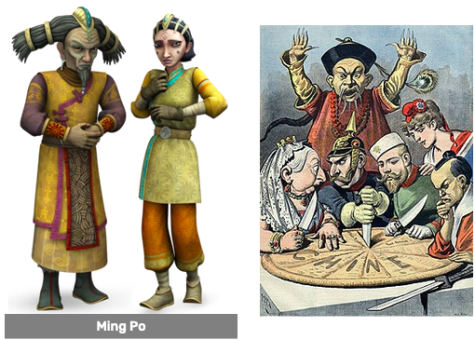
However, it is not only the Ming Po who embody anti-Asian stereotypes in Star Wars. The Neimoidians were a race of aliens who prominently featured in the Star Wars prequel trilogy and owned the Galactic Trade Federation. They were portrayed as greedy and corrupt, and were intentionally designed after Yellow Peril characters from Flash Gordon. According to the Independent: “[George Lucas’] noseless leaders of the Galactic Trade Federation are clearly a throwback to the Yellow Peril characters popular in Flash Gordon and other series, but risk being interpreted as a racial slur just as much as a fond cultural reference.” Their clothing- long robes and elaborate headdresses- are reminiscent of ancient Chinese royal clothing, and their accent and manner of speaking are very similar to human Asian caricatures from American media.
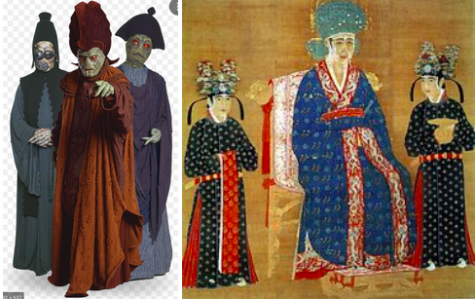
Star Wars: The Bad Batch is the latest piece of Star Wars media to utilize sinophobia for its own ends. In season one, episode ten, “Common Ground”, imagery deliberately evoking Tiananmen Square is used in the story for no other reason than to drum up emotion. In the episode, a group of anti-imperial protestors gather peacefully in a town square, facing off against several AT-AT walkers. The Imperial officer in command of these walkers is an East Asian woman, one of very few on the show. She orders the AT-ATs to attack the protestors, mirroring the firing on the protestors at Tiananmen. This is extremely tone-deaf, considering that the Empire is meant to be a metaphor for Nazi Germany and violent organized racism in general, meaning that using a person of color as a symbol for the regime destroys the point. This is also simply insensitive to the survivors and family of the victims of Tiananmen Square, considering that the tragedy occurred in 1989. Between the Neimoidians, the Ming Po, the treatment of Kelly Marie Tran, and the appropriation of Buddhist culture, Star Wars has a long history of employing racist Asian caricatures as alien designs and throwing its Asian actors to the proverbial wolves, while taking influence from Asian culture and tragedy in order to richen and deepen its world.
Like most science fiction franchises, anti-Black racism is obvious within most Star Wars media. There are very few Black characters in Star Wars, much less prominent ones. Of the more famous characters there are Mace Windu, Lando Calrissian, Saw Gerrera, and Finn. Mace Windu- possibly due to being played by Samuel L. Jackson- is afforded the best treatment out of them. He is given a position of high authority and respect as well as an integral role in the plot, even coming close to defeating Palpatine. However, he still has very little presence outside of the prequel movies, only appearing prominently in a few episodes of Clone Wars and not being mentioned at all outside of prequel media. This, however, may be partially explained by the financial strain of securing Samuel L. Jackson for a cameo appearance. Unfortunately, Mace Windu’s relatively good treatment does not extend to Saw Gerrera.
First introduced in The Clone Wars, Saw is a rebel fighter who is consistently portrayed as a violent extremist hell-bent on destruction as opposed to fighting with ‘civility’, as the protagonists and the organized Rebellion do. He briefly appears as a mellowed mentor figure in “Rogue One: A Star Wars Story” (2016) only to die within the first fifteen minutes of the movie. This racist portrayal is most egregious in “Star Wars: Rebels” (2014-2018), in which Saw spends an entire episode threatening to commit genocide against a dying species in order to obtain information about the Empire. This is contrasted against the white leader of the Rebellion, who admonishes Saw for his violence and tells him to wait for the Senate to make a decision. Saw, a Black man, is portrayed as an aggressive extremist who refuses to be civil, in contrast to the ideal peaceful Rebellion, which is represented by a white woman. This is incredibly racist, as it plays into stereotypes of Black men being animalistically violent and overly angry, as well as unable to respect rules. “The stereotype behind black people being labeled as angry dates back to slave masters. ‘If they could paint a picture of black people, in general, being angry, hostile and otherwise then they could then justify any behavior that came towards them,’ NAACP Criminal Justice and Political Action Chair LaMills Garrett said.” (via abc10.com)
Of course, the most topical example of anti-Black racism in Star Wars is the mistreatment of Finn in the recent Star Wars sequel trilogy. Finn was first introduced in “Star Wars VII: The Force Awakens” (2015) as a protagonist- the movie focused on him escaping the Empire and its brainwashing, rescuing Poe Dameron, and finding Rey. He is the inciting incident that begins the plot of the sequels and brings the other protagonists together. He is the one who wields Anakin Skywalker’s lightsaber in the movie’s climactic fight against Kylo Ren after Rey is incapacitated. He is focused on, given a meet-cute and foreshadowed romance with Rey, as well as relationships with all of the story’s most important characters, including Leia and Han Solo. However, the very next movie (Star Wars VIII: The Last Jedi, 2017) he is shoved into the background. The plot suddenly begins to focus on Rey and Kylo’s connection, on Kylo’s arc, while Finn and newly-introduced Rose Tico take the B-Plot of finding a hacker on Canto Bright and disabling a tracking device. Rey performs the deciding fight with Kylo Ren alone, and even in the climactic battle, Luke is given the fight against Kylo instead of Finn.
This, unfortunately, is nowhere near as glaring as “Star Wars IX: The Rise of Skywalker” (2019). Finn is not even an active participant in the plot- the entirety of it is given to Rey and Kylo Ren, who is redeemed and given protagonist status in favor of Finn. Rey and Kylo are given the plot-driving MacGuffin chase, the emotional moments, and the climactic fight against Palpatine. Rey and Kylo are given the core romantic relationship that was set up in The Force Awakens to be between Rey and Finn, and Lando Calrissian is given the role of instigating galaxy-wide rebellion that was again, set up in The Force Awakens to be given to Finn. There is evidence that the trilogy had originally plotted for Finn to initiate a stormtrooper uprising and feature as a protagonist, and there is concept art to prove this. As said by John Boyega himself, “Like, you guys knew what to do with Daisy Ridley, you knew what to do with Adam Driver. You knew what to do with these other people, but when it came to Kelly Marie Tran, when it came to John Boyega, you know f— all. So what do you want me to say? What they want you to say is, ‘I enjoyed being a part of it. It was a great experience…’ Nah, nah, nah. I’ll take that deal when it’s a great experience. They gave all the nuance to Adam Driver, all the nuance to Daisy Ridley. Let’s be honest. Daisy knows this. Adam knows this. Everybody knows. I’m not exposing anything.”
This, though, is secondary to the treatment that John Boyega received on the set of Star Wars and from fans. “Nobody else had the uproar and death threats sent to their Instagram DMs and social media, saying, ‘Black this and black that and you shouldn’t be a Stormtrooper.’ Nobody else had that experience.” (via gq-magazine.co.uk). John Boyega received hundreds of threats online, in addition to a boycott of the Star Wars movies sparked by his presence. The immense amount of racism and violence leveraged at John Boyega caused very real harm to him as a person. “I’m the only cast member who had their own unique experience of that franchise based on their race. Let’s just leave it like that. It makes you angry with a process like that. It makes you much more militant; it changes you. Because you realise, ‘I got given this opportunity but I’m in an industry that wasn’t even ready for me.’ Nobody else in the cast had people saying they were going to boycott the movie because [they were in it].” (gq-magazine.co.uk) Disney took no steps to defend their employee or denounce racist fans, and indeed went on to sideline John Boyega and downgrade him from protagonist to supporting character in movies that were built and marketed on his character and performance.
The sequel trilogy, and The Rise of Skywalker specifically, did not only target Finn and Rose Tico with racism. Poe Dameron, the fourth protagonist and the second main character introduced in the trilogy, is revealed in the Rise of Skywalker to have had a past as a drug smuggler. This was completely unnecessary to his character- before this, Poe was the archetype of ‘the rogue pilot with a heart of gold’, who had joined the Resistance to protect others. His having learned to fly by smuggling drugs has no impact on his character or arc and only serves to fulfill the stereotype of the Latino man being involved in drug operations. “Abundant data highlights the fact that, within the US entertainment industry, Latin Americans are most frequently cast as working in the drug trade, either as a kingpin, a hit man or a small-time dealer. According to research carried out by the University of Southern California, 25% of Latin Americans are portrayed as criminals and 17% as poverty-stricken or low-income characters.” (via elpais.com) Due to this plot development in the sequel trilogy, there are now only two non-criminal Latino characters in Star Wars: Din Djarin of The Mandalorian and Cassian Andor of Rogue One, who is dead.
Finally, anti-semitism is also very prominent in the various animated Star Wars series produced over the past decade and a half. Villainous characters in The Clone Wars are more often than not given large, exaggerated hooked noses that do not align with how the actors who portray the live-action versions of these characters look. This is most obvious in Palpatine and Dooku, who both sport large, hooked noses that neither Ian McDiarmid (Palpatine, The Empire Strikes Back) nor Christopher Lee (Count Dooku) have in real life. The protagonists, in contrast, are given small, button noses that their live-actions counterparts lack. This is most noticeable in Anakin Skywalker and Obi-Wan Kenobi, as glancing through images of Hayden Christiansen and Ewan McGregor will show that their noses are not the small, upturned button ones displayed on their animated selves. The trope of evil characters being coded as Jewish via the use of exaggerated hooked noses has its roots in Nazi propaganda and other such antisemitic work. It is mainly used in the character of ‘The Happy Merchant’, meant to display Jewish greed, control, and evil. “‘Caricatures of Jews with grotesque features, and specifically with large noses, was ubiquitous in antisemitic propaganda deployed by Nazi Germany, but can also be found in the outpourings of a wide range of antisemitic regimes, organisations and ideologies,’ said Community Security Trust Director of Policy Dr. Dave Rich, speaking to the way that these caricatures have worked as a propaganda tool over time.” (via media-diversity.org)
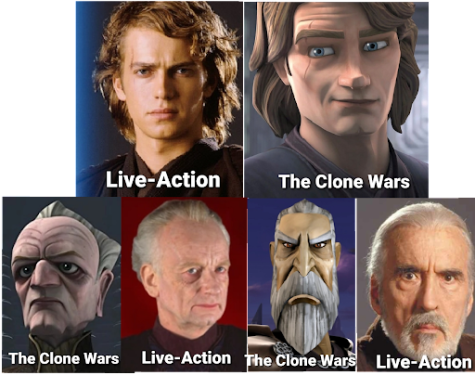
What really drives home the intentions, unconscious or not, of the stylization of the villains in Clone Wars is the redesign of the Banking Clan. Originally in the live-action prequels, the Muun, who ran the Banking Clan, were designed as noseless. These aliens are the corrupt heads of a galactic banking corporation whose motives revolve entirely around money. In Clone Wars, instead of being noseless, the Muun are designed to have enormous hooked noses that take up the majority of their face. There was no reason, behind the scenes or in-universe, for this change, except to associate hooked noses with evil and money-focused greed.
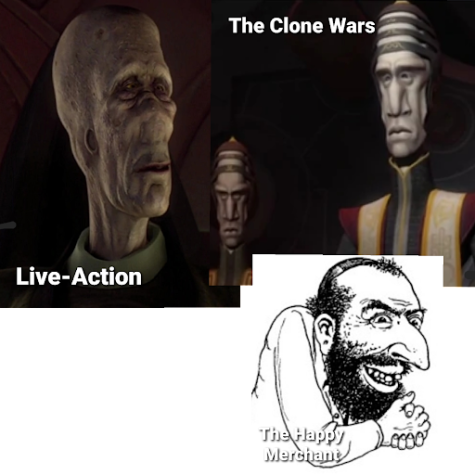
The second most recent animated Star Wars work, “Star Wars: The Bad Batch”, utilizes two different kinds of antisemitic stereotype: that of the Jewish lizard person and the Jewish mother. There is a supporting character in the show by the name of Cid, who is a Trandoshan woman (a kind of lizard alien within the world of Star Wars). Her motivations, first and foremost, are money and the pursuit of it. She is the embodiment of the ‘Jewish Mother’ stereotype, which is the portrayal of Jewish mothers as overbearing, tyrannical, and manipulative. She is also a lizard person, which is unfortunately enforcing an antisemitic conspiracy theory about Jewish lizard people that continues to thrive in alt-right communities today. To accentuate the point, she is portrayed with a stereotypical New York Jewish accent and voiced by a Jewish woman (Rhea Perlman).
Of course, animated Star Wars media was not the first nor only piece of Star Wars media to utilize antisemitic tropes. One of the most well-known instances of an antisemitic caricature in Star Wars is the Toydarian character of Watto in “Star Wars: The Phantom Menace” (1999) and “Star Wars: Attack of the Clones” (2002). Obsessed with money, Watto is portrayed with a large, stylized proboscis that hangs over his lip, resembling the hooked nose seen in antisemitic propaganda that characterizes ‘The Happy Merchant’. He also resembles ‘The Happy Merchant’ in other ways- being redesigned in Attack of the Clones to have a scraggly black beard and wear a flat black hat reminiscent of a shtreimel. He is the owner of several slaves and his only personality traits are greed and cruelty. His accent is clearly meant to be reminiscent of some stereotype, but there is no clear consensus on whether it is meant to be Arabic, Jewish, or Italian. The Toydarians make other appearances in animated Star Wars mediums, but the antisemitism of the species’ portrayal is never as pronounced as it is in the Phantom Menace.
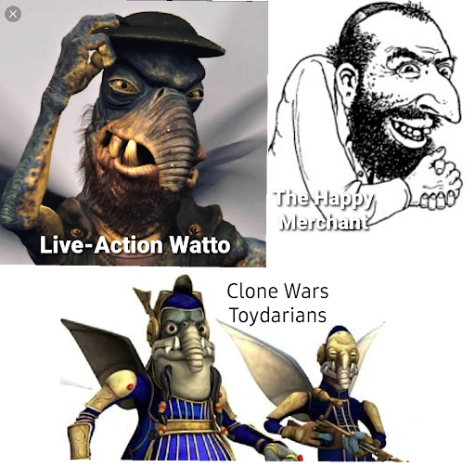
Mandalore is a large player in the annals of racism within Star Wars. Mandalore is a planet that was originally created as a backstory for the Fetts, which led to the creation of the Mandalorians. These people are heavily inspired by Māori and other Polynesian culture, owing in part to the fact that the most prominent Mandalorian characters in Star Wars are played by Temuera Morrison, a Māori man. Inspirations from Indigenous culture include the Keldabe kiss– a Mandalorian gesture of affection in which two people touch their foreheads together- which was inspired by the Māori Hongi, an extremely similar gesture. Another example is the practice of Mandalorian adoption, Gal Bai Manda, which involves the specific phrase “I know your name as my child.” This was inspired by Hānai, a Hawaiian adoption practice that involves the specific phrase “Yours is the child, excreta, intestines and all.” Before the debut of The Clone Wars cartoon, there were a plethora of Star Wars novels and comics that delved into the backstories of Boba and Jango Fett, fleshing out the Mandalorian culture and often drawing inspiration from elements of Māori and Hawaiian culture. While the comics were often whitewashed, it was still miles ahead in terms of representation than The Clone Wars would be.
In The Clone Wars, the planet of Mandalore is shown onscreen for the very first time, and it is revealed to be inhabited exclusively by blonde-haired, blue-eyed white people. “The New Mandalorian populous [sic] was overwhelmingly composed of Humans, with fair-complected skin, and primarily blonde hair, though individuals with brown and red hair were known to exist within the New Mandalorian faction. This racial homogeneity stood in stark contrast to the traditional warrior clans, in which Humans of a variety of skin colors and aliens from a multitude of species all stood together as Mandalorians, regardless of outward appearances.” (via Wookieepedia)
Furthermore, the leader of Mandalore, Satine Kryze, explains that all ‘war-mongering’ Mandalorians were forcibly expelled from Mandalore years ago in pursuit of peace. “Death Watch and their goals were ultimately thwarted, as a number of defeated but unrepentant Mandalorian warlords accepted exile to Mandalore’s moon Concordia, where the New Mandalorian government assumed and expected that they would die out.” (via Wookiepedia) This, along with the complete lack of any non-white people on Mandalore, carries the implication (however unintended) of a cultural genocide perpetuated by the white elite in a way heavily reminiscent of how real-world genocides of Indigenous people were carried out under the guise of ‘peacemaking’. What’s more, Disney on April 25th 2014, after buying Star Wars, proceeded to decanonize (declare to be not an official part of the universe) all pre-Disney Star Wars novels and comics- and by extension the Fetts- effectively retroactively whitewashing Mandalore into a planet of eurocentric white people.
The whitewashing of Star Wars is the most obvious and most pervasive form of racism that can be found throughout the series, and continues today. The most noticeable form of whitewashing in Star Wars is the design of the clones within The Clone Wars and The Bad Batch, though the clones are not the only victims. The clones, within the narrative, are all clones of Jango Fett, who is played in his live-action appearances by Temuera Morrison. Morrison is a Māori man, but this is impossible to tell from the design and coloring of the clones. According to @clonehub, “I’m starting to lean toward an entirely negative mindset about the clones’ portrayal. Since they’re not played by a Māori voice actor, their accents are completely wrong. Actual [people from Aotearoa] can’t recognize them as being from [Aotearoa]. While the face models in the update were an improvement in general, they also got whiter and they still aren’t that close to Temuera Morrison’s face. And writing wise, I feel like they didn’t get the attention they deserved.”
Indeed, the clones are collectively played by a single voice actor, Dee Bradley Baker, a man who is both white and not from Aotearoa. In addition, their animation designs have straight hair, sharp and triangular noses, angular faces and lightened eyes. Their skin is also pale, despite being based on a brown-skinned man. This only worsened after the show underwent an animation update in season four, which further lightened the clones’ skin as well as their hair, and redesigned one specific character in such a way that he no longer even vaguely resembled his live-action counterpart.
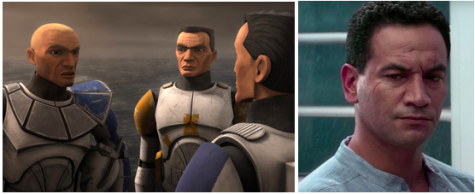
Boba Fett appears sparsely in The Clone Wars as a child/tween, and while his design in the first three seasons of Clone Wars was still whitewashed, the season four version of him was much worse. His skin was drastically lightened along with his hair, and his features were sharpened, to the point where he bore no resemblance to Daniel Logan– the child actor who played Boba Fett in the prequel trilogy- nor to Temuera Morrison, the man he was meant to be a genetic copy of.

While the clones are the most noticeable victim of whitewashing given how often they appear in Star Wars media, they are not the only ones. A common problem plaguing Star Wars animation is an extreme overabundance of blue and green eyes. Characters portrayed as people of color are much more likely to have blue or green eyes than brown, and it is legitimately difficult to find examples of brown eyes in the casts of animated Star Wars productions. Saw Gerrera is portrayed alternately as having blue or green eyes depending on the series, Kanan Jarrus and Ezra Bridger have green and blue eyes respectively despite being men of color, Ahsoka, Barriss, and Luminara are all given blue eyes in spite of their coding as women of color, and the list goes on.
Allegorical racism is also butchered with whitewashing by The Clone Wars and Rebels. In addition to using slavery as a cheap plot point and a reason to hate the series’ villains- the Separatists- while refusing to acknowledge the fact that the protagonists participate in slavery, The Clone Wars also turns the Twi’leks’ struggle for freedom into an allegory for the French Revolution. The Twi’leks, a species in Star Wars that is heavily enslaved and besieged by more powerful governments for their own gain, are given French accents in Clone Wars and Rebels in order to draw a parallel between them and the struggles of the French peasantry. This is an issue, considering that the French peasantry were never enslaved and the plight of the Twi’leks much more closely mirrors Haiti and Ethiopia in their fight for freedom against enslaving colonizers.
Slavery in general is upsettingly glossed over in Star Wars, used as tragic backstory fodder and a reason to dislike villains instead of treating it as the horrific real-life practice that it is. This becomes all the more egregious when paired with Star Wars’ unwillingness to admit that the clones are, by every conceivable definition of the word, enslaved by the Republic. They are brainwashed and trained from birth to fight for a government that legally does not recognize them as citizens nor as people. They have no right to own property, vote, or even earn money, as the Grand Army of the Republic does not pay them and they are not allowed to leave the army. Doing so amounts to deserting, and is punishable by imprisonment. The clones are bred and raised to be soldiers, with no choice in the matter, considered property, unable to leave their situation, and hunted down if they do attempt to escape. They are explicitly referred to as property to be bought and sold by characters in The Clone Wars, and in the very first episode a clone character says, verbatim: “We’re clones. We’re meant to be disposable.” Despite all of this, Star Wars continually refuses to acknowledge the clones’ predicament for what it is.
Star Wars: The Bad Batch is the latest Star Wars property starring the clones, and quite possibly the most egregious with its whitewashing. The characters that appear in it, Clone Force 99 or ‘The Bad Batch’, first appear in season seven of The Clone Wars in an episode of the same name. They are portrayed as ‘genetically superior’ clones- ones with “desirable mutations” that allow them to be better at combat and thus more valuable than the “regs” or regular clones. This is already a premise that reeks of eugenics and has many problems, but where it gets worse is in the aesthetic design of the Batch. They have significantly altered features to the regular clones- narrower faces, sharper noses, smaller eyes and chins, and lightened skin, eyes and hair. The one exception to this is Wrecker, who is designed to look the closest to Temuera Morrison, and has a personality described as “…characterized by a number of negative racial stereotypes, including being violent / short-tempered, intellectually inferior, and to quote voice actor Dee Bradley Baker, ‘childlike’.” (via An Open Plea From Fans Of Color)
This is especially problematic due to the fact that the Batch is portrayed as ‘smarter’ than the average clones- Tech, due to being a negative stereotype of an autistic person, is incredibly efficient at all things computers and math, as well as a host of other plot-relevant skills relating to information. Hunter, whose appearance “Many people likened… to Sylvester Stallone’s Rambo” (via An Open Plea From Fans Of Color) is able to remember and pull off complex battle strategies and sense enemies approaching due to his genetically enhanced senses. Crosshair, easily recognizable via his “dramatically narrowed features and yellow undertone” (An Open Plea From Fans Of Color) can execute absurdly precise sniper shots and perfectly utilize physics to shoot around corners and through multiple enemies. The only two characters who are not portrayed as ‘genetically smarter’ are Wrecker, who is a racial stereotype of an angry brown man, and Echo, who is a loan character from The Clone Wars and not genetically enhanced.
In addition to these characters, we are introduced to Omega, a young clone who is used as both a reason to sympathize with the protagonists and a MacGuffin for the villains. She is, within the narrative, a perfect clone of Jango Fett- with no mutations or impurities. “Omega was an unaltered, yet enhanced human female clone created from the genetic template of the Mandalorian bounty hunter Jango Fett who lived in the years following the Clone Wars. Originally created as a pure genetic replication of Fett, she was a medical assistant to Nala Se and spent her days working in Tipoca City on the clone homeworld of Kamino.” (Wookieepedia) Without delving into the logical confusion behind whether Disney meant this plot point to retroactively make both Jango and Boba Fett transgender, this story decision does not work due to the whitewashing of Omega. She has dramatically lightened skin as well as blonde hair, two traits that Jango Fett decidedly does not have. Several plot points depend on her being a pure, exact clone of Jango Fett, despite the clear visual evidence to the contrary. This clash between storytelling and animation is a clear indicator that Disney will prioritize whiteness over its duty to storytelling.

It is not only new characters that The Bad Batch whitewashed, however. Echo, a supporting character from The Clone Wars, is brought back from the dead and into The Bad Batch in season seven: episode four, “Unfinished Business”. In the four episodes preceding it, he is revealed to have been held captive in a coma by the Techno Union for somewhere around a year, having been used to feed information on Republic attack plans to the Separatists via computer links to his brain. Because of this prolonged comatose state held in a coffin, he is extremely sickly-looking by the time he is released. The problem is with how his sicklyness is displayed visually. His skin is paper-white, instead of paled. This is a problem due to the fact that Echo is, like all other clones, meant to be a clone of a brown-skinned man. Melanin does not disappear during prolonged absence of sunlight- the skin simply grows paler and grayer. Echo’s skin should be pale brown after being in a coma for a year- not paper-white. The argument that this is not whitewashing due to the fact that it is justified by events within the story is a fallacy known as the Thermian Argument– the creators of The Bad Batch and Clone Wars deliberately chose to put Echo into a situation where they could conceivably get away with lightening his skin, and then took that situation as far as they possibly could.
The background characters of The Bad Batch are also whitewashed, in addition to the leads. Kanan Jarrus, one of the main characters of Star Wars: Rebels, appears for a single-scene cameo as a padawan in the very first episode. He is referred to as Caleb Dume, as that was his given name before he changed it following his escape from Order 66. Kanan, in Rebels, has light brown skin and dark brown hair, as well as a large, hooked nose, effectively portraying him as a man of color in the show. However, in The Bad Batch, padawan Caleb has very pale skin, pale red hair, and blue eyes. His nose has become a button nose, and he is nigh-unrecognizable as the Rebels character. This is an inexcusable and extremely blatant instance of whitewashing, and it is not the only one. Saw Gerrera also appears in The Bad Batch, with green eyes, light brown skin, and straight brown hair. This design bears no resemblance to any of his previous designs nor to his live-action appearance in Rogue One, and serves only to make him appear more eurocentric. Fennec Shand is also, unfortunately, whitewashed in The Bad Batch. Thankfully, she is whitewashed the least, as she is allowed to keep her dark hair and eyes, but her face and forehead are elongated and her eyes are widened in such a way that causes her to appear closer to a white woman than the Chinese actress, Ming-Na Wen, whom she is modeled after.
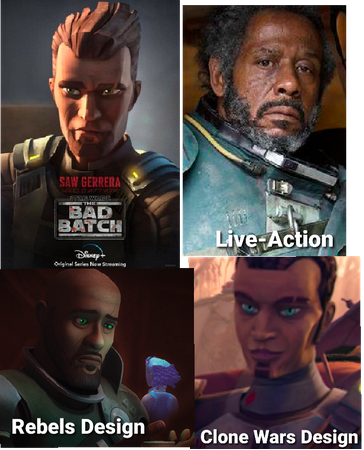
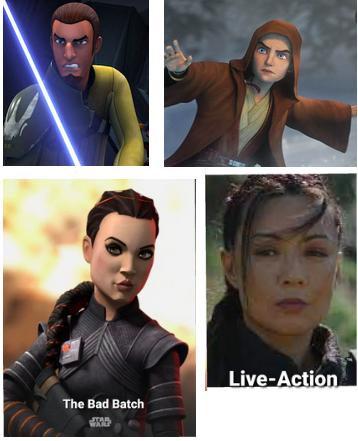
An argument that may be leveraged in opposition to the one positing that characters are being deliberately whitewashed is that they are simply being translated into a new animation style. This is false, as there are multiple side characters of color with dark brown eyes, hair, and skin. There are also several Black side characters with properly rendered curly hair, leaving no excuse for Saw’s and the clones’ hair being straightened. The problem with these side characters is that the majority of them are villains, working for the empire. Most of them appear in Crosshair’s death squad in season one, episode three “Replacements”. They have no personalities, and only serve to assist Crosshair in the brutal murders of several civilians. The Death Squad is made up entirely of people of color, with the exception of a single white man, who is executed for objecting to the murder of civilians. He is the only one to object.
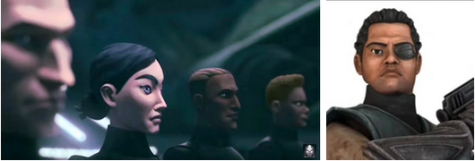
Due to this rampant whitewashing, Star Wars fans of color have formed a movement called “UnWhiteWashTheBadBatch” that aims to convince Disney to revamp the story and animation of the Bad Batch in order to eradicate the racism inherent in it, as well as bring awareness to the racism within both Star Wars media and its fandom. In addition to its stated goal, the movement also participates in anti-racist events within fandom and uplifts artists of color online by spotlighting their work. UWWTBB partakes in tweet storms on Twitter under the hashtag #UnwhitewashTheBadBatch, and has a change.org petition as well as an official Tumblr blog, Twitter account, Instagram, Tiktok, YouTube and Facebook. They were the ones to compose the Open Plea From Fans of Color referenced in this article, and they have also created a comprehensive carrd detailing the racism and myriad other issues in The Bad Batch. In the words of @clonehub, the progenitor of the UnWhiteWashTheBadBatch hashtag, “…it’s a concerted effort by fans of color to address and demand remedies for the racism in The Bad Batch.”
While fandom can be a place in which movements such as UWWTBB begin and racism is challenged, it can also be a place for racist and complacent white fans to perpetuate racism against characters and fans of color alike. The characters of color in Star Wars are often subject to sidelining, fetishization, character assassination, and general abuse by white fans. In the words of @clonehub, who has been the target of much harassment by white fans as a result of being a self-described vocal Black blogger, “General racism [in the fandom] is incredibly high, like any other white-dominant space.”
Characters of color are often treated one of three ways by white fandom: Ignored, demonized, or fetishized. Most East Asian characters are given the first treatment- Rose Tico is very rarely included in fanart and fanfiction about the sequel trilogy, while minor white characters such as General Hux are intensely fixated on to the point of almost becoming main characters. Mace Windu is a prime example of the second treatment in fandom, being very commonly denigrated and slandered by white fans of Anakin Skywalker who characterize Mace as an angry, cruel Black man who was one of- if not the- main causes for Anakin’s fall. As said by @clonehub: “People still blame Windu for Anakin’s fall like Palpatine doesn’t exist. He’s stereotyped as entirely mean and unfair, when he’s shown more compassion for the clones than literally any of the other Jedi we see on screen–including Ahsoka, Anakin, and Obi-wan combined.”
Indeed, canonical information does not support the fan perception of Mace Windu. Despite his sparse appearances, there are many examples of Mace showing kindness and compassion to his soldiers, while many of the other characters regard them, however implicitly, as cannon fodder. He is shown smashing through the windshield of a tank in order to drag an injured clone to safety, cradling the body of a dying clone in season two, episode twenty of Clone Wars, “Death Trap”, and shoving his men to safety at the expense of his own when an energy bridge deactivates in season one, episode twenty-one “Liberty on Ryloth”.
The third treatment given to characters of color by white fans, fetishization, is most commonly seen in fanworks surrounding the clones, Jango and Boba Fett, and Din Djarin. The most recognizable form of fetishization is of the violent, animalistic variety; according to @clonehub: “[Fetishization is] getting worse in the fandom, and everyone takes it incredibly personally when you point it out. Most of the fics are self-insert ship fics written by white people… Someone once fully wrote the clones as hive minded men with animalistic, base desires and aggression that they could barely control- a whole stereotype. It went accepted by their followers until several people found it and got angry.” This form of fetishization ties into old stereotypes of Black and Brown men being sexually violent, animalistic aggressors who would violate and otherwise endanger white women. The sexual fantasy is a simple and common one- to be dominated. While there is nothing inherently wrong with a domination fantasy, bringing racial stereotypes that have and still cause violence in the real world into it makes it harmful. This fetishization is at its core a white victimization fantasy relying on racist stereotypes and perpetuating very real harm against men of color, and it is a problem in the Star Wars fandom.
The second and less recognizable form of fetishization- which, while not always sexual in nature, can be- is infantilization. As said by @clonehub: “Most of the [fetishization] fics are self-insert ship fics written by white people. Many people view [the clones] exclusively either as aggressors or as adult children who need a guiding hand to become people… The fetishization runs on the extremes of either infalitization (tied with white saviorism) or animalistic aggression and domination (tied with white victimization).” This form of fetishization is exclusively applied to the clones, and operates as a form of white saviorism. It is the fantasy of centering oneself in the narrative of anti-racism, and saving a person of color from their struggles. Those who make works utilizing this form of fetishization often argue that the clones are children, as due to their accelerated aging the eldest of them are at most thirteen. They ignore all evidence that the clones are fully-grown, developed men in pursuit of a story in which either they or a white character steps in to save the helpless Brown characters from the misery they are unable to escape. Popular iterations of this involve prominent white characters, usually Obi-Wan Kenobi, winning the war and personally freeing the clones from their servitude. It also frequently involves white characters (again, usually Obi-Wan) naming the clones, teaching them about Mandalorian culture (due to being clones of Jango Fett, the clones are commonly interpreted as Mandalorian) or even creating a new culture for them. This is more closely tied to narratives used to justify colonialism, wherein Brown people are incapable of formulating an identity or ‘civilized’ culture, and must be taught how to do so by the white man. This bigotry is laid out in Rudyard Kipling’s “The White Man’s Burden”.
Those who do not make the argument that the clones are children are often the ones using the infantilizing form of fetishization as a sexual fantasy centered around extreme ignorance; a gender-swapped variation of the ‘Born Sexy Yesterday’ trope. In this particular variation of the trope, clones are portrayed as ignorant of concepts surrounding women’s anatomy and reproduction. Setting aside the fact that this is unrealistic in terms of the education the clones would receive, this is an example of the infantilization of people of color, the viewing of them not as capable adults with thoughts, feelings, and opinions, but as incompetent and underdeveloped beings in need of help. The sexualization of this is also slightly disturbing, contributing to the already rampant sexual objectification of people of color in real life.
Whitewashing is also incredibly widespread in fandom, with fanart often lightening characters’ skin tones and eyes, straightening their hair and giving them eurocentric features, such as upturned, thin noses and sharpened chins. This is mainly out of ignorance rather than malice- most beginner artists draw the clones based off of their whitewashed Clone Wars models- but it is whitewashing nonetheless. What is less ignorant and more malicious is experienced artists who simply never bothered to learn how to draw nonwhite faces and features, and are unable to properly color skin tones which are not white ones. This is out of willful ignorance- choosing not to learn and grow in order to combat racism.
All of these problems, however, concern the treatment of fictional characters within fandom. Far more worrying and causing much more direct harm is the harassment of fans of color within fandom spaces. Black and Indigenous fans in Star Wars fan communities who attempt to draw attention to racism or even simply exist as themselves receive extreme amounts of backlash, hate, and harassment by white fans. @clonehub, as a Black blogger who is one of the main contributors to UWWTBB, has experienced online harassment and was willing to speak about it for this article. “[AntiBlack racism in the Star Wars fandom is] bad. I’m lucky I haven’t gotten the worst of it, as a vocal Black blogger–but the casual antiBlackness can be seen in the overuse of broken AAVE. Most of the antiBlackness is leveraged against the Black characters in the franchise. All of them.”
“I’ve gotten slurs, people speaking over me, people accusing me of being a bully conveniently now that I’m expressing a zero tolerance policy for racism. My friends keep getting harassed. I’ve had people say that my Māori friends who didn’t like the way the clones are portrayed are ‘soft’. I’ve had people dismiss the racism in the show and in the fandom. People accused me of being white, of not actually caring about what I’m talking about, etc. The same thing has happened to all my friends of color in this fandom. The anti semitism is pretty bad, too. Most of this direct and indirect antagonism is levied by white fans against us fans of color under the guise of wanting to get rid of ‘bullying’ and ‘antis’. I’ve written essays on it on my blog.”
The racism in both Star Wars and its fandom is immense, but there are pieces of Star Wars media which aim to uplift people of color and remedy the horrors created by past works. There are also positive portrayals of Indigenous culture incorporated into some of the elements of Star Wars’ world. For example, in the ongoing “The Mandalorian”, Temuera Morrison returns as Boba Fett and has included some of his own Māori culture into Boba Fett’s accessories and fighting style. “If you were wondering, that is, in fact, Morrison wielding it, as he’s fluent in the Maori art of stick fighting. ‘I was able to bring that into this production. Robert could see that I could use the weapon and swing the stick around. In our own culture, we have a staff that’s called a taiaha. I’d been trained in that as a young boy, as well.’” / “I come from a warrior background in New Zealand. I’m a Māori, and I’ve been trained. It gives me something to draw on. I was trained as a young boy back in New Zealand in the art of our haka [warrior dance]. ‘Ha’ is the breath, and ‘ka’ is the fire. I’m using my warrior background as a source of energy and as a source of confidence.” (via starwars.com)
Also in The Mandalorian, the Tuskens- previously portrayed as subhuman and animalistic- have been given a language, motives and personhood beyond anything seen on the screen before. They now communicate via sign language, negotiate terms with those wishing to pass through their territory, and keep pet massiffs. They are depicted as a people to be respected, instead of brutish obstacles for the protagonists to overcome. There is even a suggestion that Boba Fett may have spent time with the Tuskens at some point, as the staff he wields while fighting is a Tusken ganderffi. This suggests that he may have received it from and possibly been trained to use it by Tuskens who trusted him.
However, possibly the (narratively) best onscreen representation for people of color in Star Wars is the 2014-2018 cartoon “Star Wars: Rebels”. Featuring three lead characters of color whose designs (aside from the blue/green eyes) are properly colored and rendered, as well as updated models for the clones that include wide, round noses and faces that actually resemble Temuera Morrison’s, Rebels is well-known within the Star Wars fandom as one of the most racially-sensitive pieces of televised Star Wars media out there. Sabine Wren, specifically, is an Asian girl who is also part of an in-universe minority group- Mandalorians- and this is made a part of her character, but she is also given an identity outside of it. The show also deals with themes of the aftermath of genocide and how it affects the people who experienced it in such a way that is meaningful, and the subject is given the weight it deserves.
Another example is “Star Wars: Visions” (2021), a new Disney+ exclusive series that translates Star Wars into the world of anime, symbolically giving back the elements of Asian culture taken by George Lucas for token aesthetics years ago. One of the upcoming novels based on one of its episodes, “The Duel” (season one, episode one), called “Star Wars Visions: Ronin” will not only feature Asian characters, but multiple queer and trans characters.
There are also a plethora of books, games, and comics within the Star Wars universe created by people of color, including Star Wars: The High Republic, a game recommended by @clonehub: “I’ve been hearing that the high republic is loads of fun, and I know that some or most (not sure if all) the writers for it are people of color.”
Star Wars has a long, complex, and ugly history with race and racism, but there are fans and creators of color alike working to expand the franchise beyond its unfortunate origins and give the next generation of non-white sci-fi fans something to latch onto. Support those people, and help out movements such as UnwhitewashTheBadBatch as well as spending your money on works that they have created. Star Wars may never be able to escape the racism of its past, but its fans can mold it to avoid the racism of the present, as well as the future.
A $50 or more donation includes a subscription to the Clayton High School Globe 2024-2025 print news magazine.
We will mail a copy of our issues to the recipients of your choice.
Your donation helps preserve the tangible experience of print journalism, ensuring that student voices reach our community and that student democracy thrives.

Ezri Perrin is a senior at Clayton High School and a reporter for the Globe. They have been with the Globe since freshman year. They are passionate about Star Trek, human rights,...


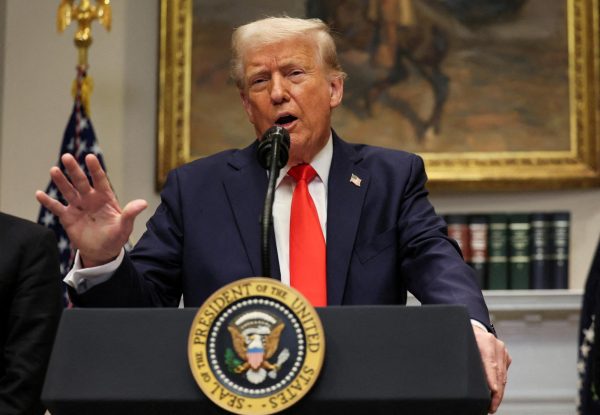




Milo • Oct 19, 2024 at 11:31 pm
Absolutely fascinating, Ezri. First off, when I reading this I did not notice it was from a high school website and it read as a scathing commentary on star wars from a professional activist. You should be proud of how brilliant you are and how advanced of an understanding and perspective you have for a child.
PS. Tell your webmaster this article was very prominent on google, so good job on SEO there.
Give this kid an award • Oct 3, 2024 at 10:15 pm
I got to the very end of this article, looked at the “About the Contributor” section, and went “this was written by a high school student??” Wow, very impressive work!
WokeFilonieshil69 • Jul 18, 2024 at 5:59 am
Terrible Article full of cherry picked opinions and Lies, Most of these complaints are complaining about pointless drivel, animations styles explain different apparences across shows, clones were voiced acter by a Crackkker because it was cheaper to get a Amerikkkan to voice act, Muuns Look like villagers from minecraft tho watto and the toydarians are sus appreance wise, but pretty much everything else is chery picked and lies. – from a Crackkker ps bigots get the rope
Yor Reeson • Mar 21, 2024 at 8:34 pm
Exaggeration by pointing race issues in someone’s artistic fiction and cultural designs is a sign of racial intolerance. Star Wars is a fictional world, not realistically portrayed modern or future USA. Racism (if any) is used by evil characters/groups like the Empire (which was based on real life Nazis).
Is a black man allowed to make an original, fictional world with mostly black people? Absolutely yes. That’s just someone’s vision (potentially interesting one)
Is a white man allowed to make an original, fictional world with mostly white people? WAS. Apparently isn’t anymore. No freedom for creators. Put censorship and terror on them to impose political/ideological beliefs and we get fascism.
The world of fictional entertainment needs to remain free to express. The problem with modern Hollywood is DEI (IRL politics) over immersive fictional plot of creators.
Roger • Jan 1, 2024 at 7:55 pm
I agree. Racism has been an issue in star wars ever since its creation. Although I believe the article should’ve brought more examples (more references and images) to prove its point, instead of just citing a bunch of them, for the author of it is white, thus rendering some of the emotional content of it as insincere and unearned. The author should’ve brought more factual examples of the opinions of POC, which should’ve been the ones to point out this problem in first place. Great article tho, good job cataloguing racist stereotypes in star wars media!
Cam Cam • Jun 18, 2023 at 3:56 pm
And they didn’t even mention Jar Jar…so problematic. I love star wars but difficult to disagree with much of this.